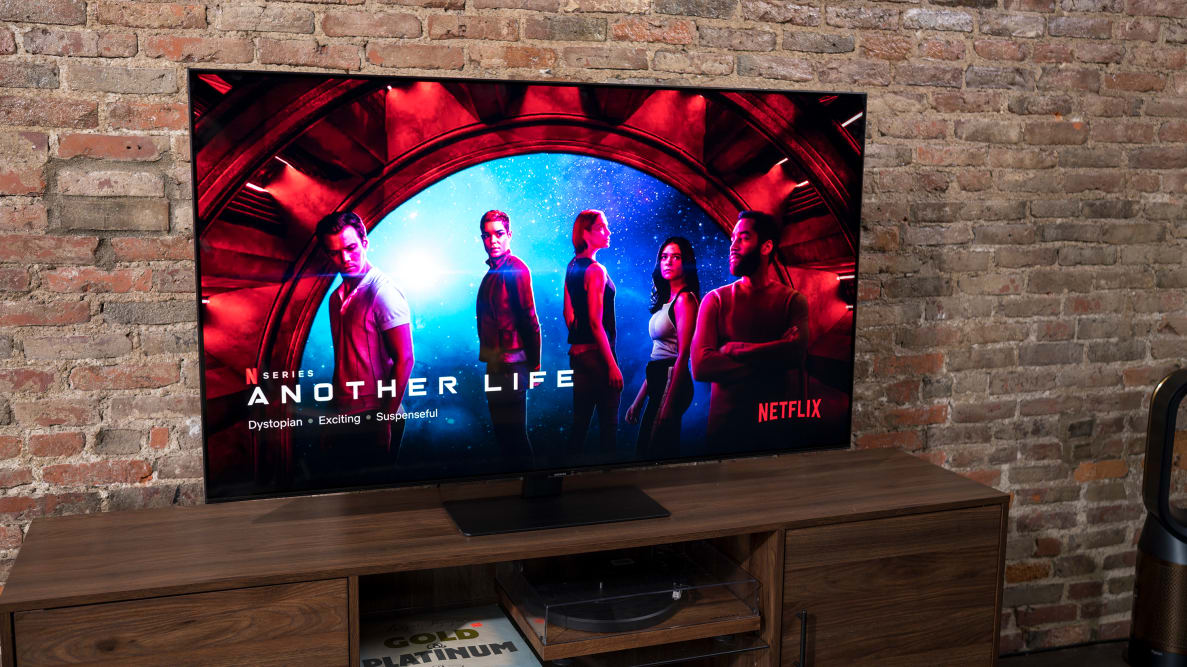Pros
-
Sleek design
-
Terrific extras
-
Bright, colorful picture
Cons
-
Disappointing black levels
This year’s Q80A uses an IPS-style LCD panel—technically ADS, but it's an IPS variant—meaning it doesn’t have the best black levels. For a lot of videophiles, that’s a deal-breaker. While IPS (in-plane switching) LCD variants foster good color and wider-than-average viewing angles compared to VA (vertical alignment) style panels, they can’t block light as well, making for issues like backlight bleed, bloom, flashlighting, and poor contrast.
So while the Q80A may be kitted out with many of the stellar features and design details we loved while reviewing the flagship QN90A, it’s a little too expensive (per size) for a TV that won’t look great in a dim or dark viewing environment. If you want the Samsung look and features with stellar picture quality, you might need to shop Samsung's higher-tier TVs. If you just want great 4K/HDR picture quality and don't mind a plainer, less feature-stuffed TV, TCL and Vizio both offer good alternatives.
Editor's note: Due to COVID-19 considerations, this review leans heavily on testing data in lieu of hands-on time with the TV.
About the Samsung Q80A Series
This year, Samsung’s Q80A series is available in a moderate range of larger screen sizes:
- 55-inch (Samsung QN55Q80A), MSRP $1,299.99
- 65-inch (Samsung QN65Q80A), MSRP $1,699.99
- 75-inch (Samsung QN75Q80A), MSRP $2,599.99
- 85-inch (Samsung QN85Q80A), MSRP $3,699.99
As noted above, these TVs aren’t relatively pricy: $1,300 for a 55-inch TV is nothing to sneeze at, but part of what you’re paying for here is the sheer amount of features. Here are the important specs for the Q80A series:
- Resolution: 4K (3,840 x 2,160)
- Display type: QLED (quantum dot + direct full array backlight)
- Dimming technology: Supreme UHD Dimming
- HDR support: HDR10, HDR10+, HLG
- eARC support: Yes
- Native refresh rate: 120Hz
- Smart platform: Tizen Smart TV
- Color: DCI-P3 color space/10-bit chroma resolution
- Processor: Quantum Processor 4K
- HDMI 2.1-compatible: Yes
- Other features: Object Tracking Sound (OTS), Adaptive Picture, Q-Symphony, SpaceFit Sound, Active Voice Amplifier (AVA), Motion Xcelerator Turbo+, Super UltraWide GameView, Game Bar, FreeSync Premium Pro, PC on TV, Multi View, Tap View, Bixby/Amazon Alexa/Google Assistant, Samsung TV Plus, Samsung Health
Samsung didn’t skimp on features for this TV: you’re getting picture upgrades like quantum dot color and 120Hz refresh rates, an HDMI 2.1-compatible input, and almost as many extras and features as you’ll find on the flagship Q90A. Features and design elements are identical regardless of which size you buy, and because every TV in the Q80A series has the same quantum dot color and full-array LED backlight, we expect picture quality to be very similar between sizes.
For this review, we tested a 55-inch Q80A purchased online from Amazon.
Performance Data
We test TVs in a light-controlled lab at our HQ in Cambridge, MA, but beforehand, we assemble it and run a moving test pattern on the screen for a minimum of 24 hours, which gives it time to warm up and settle into continuous operation.
The performance data below is gathered during our suite of test procedures, most of which rely on objective lab data gathered via light-measuring meters aimed at the screen during test patterns. Currently, we use different meters to measure luminance (black/white data) and color, but both utilize the QuantumData 780a signal generator to provide 4K test patterns to the TV. We use SpectraCal’s CalMan Ultimate software to tabulate test patterns and perform measurement sweeps.
For the Samsung Q80A, we took SDR and HDR measurements in the “Movie” picture mode. Here are the key takeaways from the testing process:
- HDR checkerboard contrast (reference black level/brightness): 0.39 / 588.30 nits
- SDR checkerboard contrast (reference black level/brightness): 0.188 / 268.50 nits
- HDR peak brightness (sustained): 913.60 nits
- HDR (DCI-P3) color gamut coverage: 89.1%
- SDR (rec.709) color gamut coverage: 99.1%
Connectivity
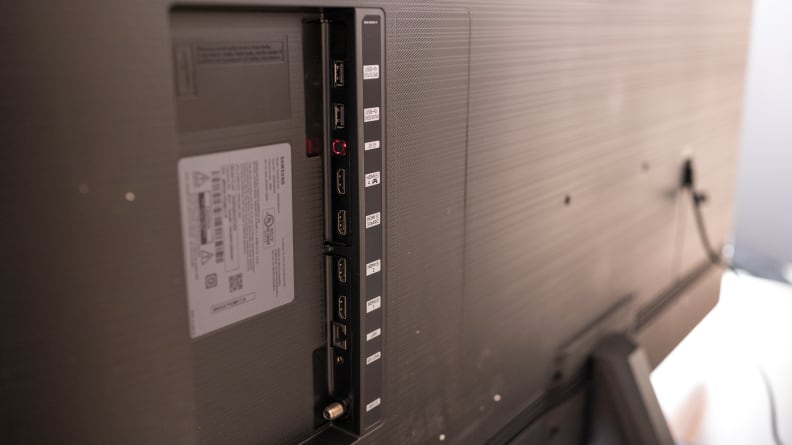
The Q80A TVs feature four HDMI inputs and two USB 2.0 ports, but only one of the HDMI inputs (HDMI 4) is HDMI 2.1 compatible.
The Q80A is stuffed with features and available only in big screen sizes (55 inches and up), so it makes sense that it’s got ample connectivity options. Here’s what’s on the back of the panel:
- 4 x HDMI (HDMI 1-3 are 2.0, HDMI 4 is 2.1)
- 2 x USB 2.0 ports
- Ethernet (LAN) input
- RF in (for cable/satellite)
- Digital audio out (optical)
What we like
Easy on the eyes
Televisions really don’t need to look sleek or aesthetically pleasing—the majority have been boxy and charcoal-colored for decades, and nobody’s complained much. But we always appreciate it when a TV adds a bit of design flourish, and the Q80A does just that.
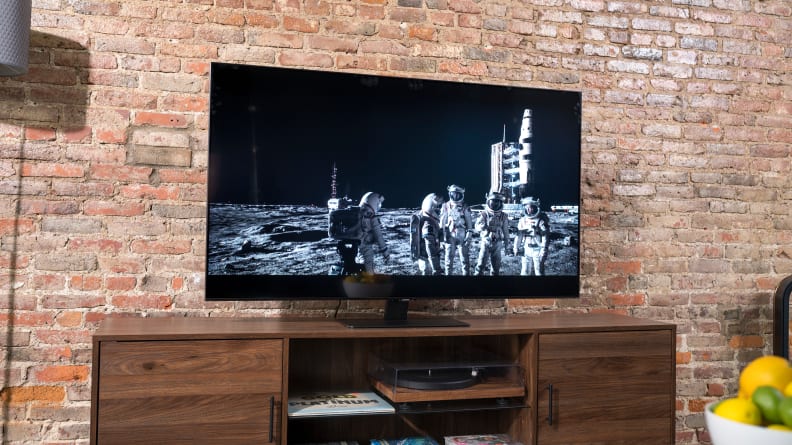
The Q80A blends into just about any room easily, but on closer inspection, it's sporting a minimalist design with handsome details.
At first glance, this TV is very standard: black bezels, black stand, rectangular screen. Big whoop. But a closer inspection reveals carefully edged corners, an almost bezel-less display, and a handsome, glass-topped stand that boldly abandons the dual caltrop-shaped feet that most TVs have utilized in recent years. It’s a look that can blend nicely into any room, but that you won’t want to hide in an entertainment center either.
Like Samsung’s other 2021 QLED models, you’re also getting the eco-friendly Solar Cell remote with the Q80A. It looks (and works) just like a traditional Samsung remote, only it doesn’t have (or need) batteries. Instead, it charges up via indoor or outdoor light and runs on solar energy—pretty cool stuff. Of course, if you’ve got a particular lightless viewing environment, you’ll be glad to know you can also charge via USB.
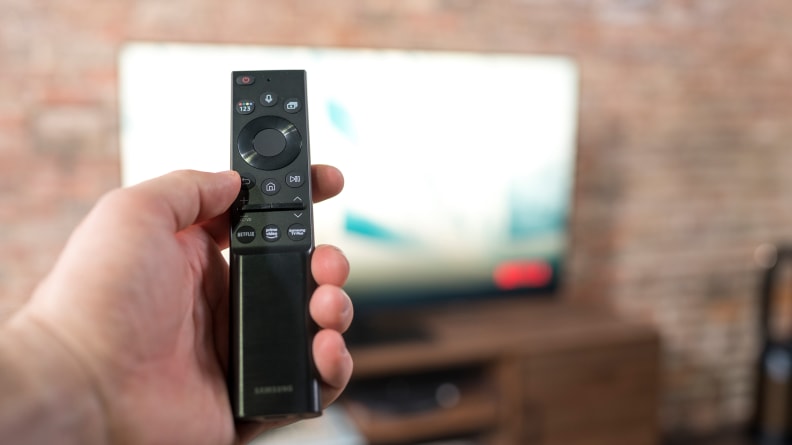
The included Samsung Solar Remote is eco-friendly and doesn't use batteries. It charges via indoor light, outdoor light, or over USB-C.
Even the backside of this TV looks nice. Molded, horizontal lines create an inviting canvas of durable plastic, where you’ll find a cutout with all of the TV’s AV inputs and ports.
A bright, colorful picture
We may have some qualms about how the Q80A’s IPS panel renders shadow tones (more on that in a bit), but from a picture quality standpoint, this TV still gets more things right than wrong.
With the Q80A, you’re looking at a fully-equipped, next-gen ready 4K/HDR TV: quantum dot color means standard and HDR content really pops (especially reds, greens, and yellows); solid peak brightness (500+ nits) means HDR games and movies will look way better than average; and, for what’s it worth, the IPS panel does deliver wider horizontal viewing angles, meaning more people can group around this TV in a large room without off-angle viewing degradation.
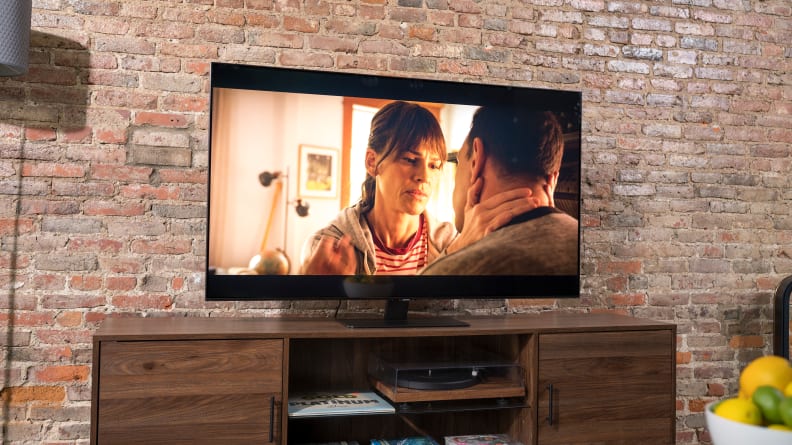
Equipped with an HDR-ready full-array backlight and quantum dots, the Q80A presents a bright, colorful picture.
You’re also getting HDMI 2.1 compatibility (plus eARC) and native 120Hz refresh rates, which is great news for 24fps film fans, gamers, and anyone who wants the smoothest motion they can get. The Q80A is equipped with the same motion engine as the excellent QN90A flagship, so while it may not have the same contrast performance nor quite the same intensity of color saturation, it’s still delivering a lot of solid traits.
A smorgasbord of features
The laundry list of features on this TV almost justifies its not inconsiderable price tag. You’re getting a ton of functionality here, including:
- Tizen Smart TV, a fully-featured smart platform that gives you access to streaming apps, a browser, Smart Home functions, voice assistants, and free Samsung content
- Adaptive Picture and SpaceFit Sound, which attempt to use algorithmic learning to tailor the picture mode and sound quality (respectively) to your viewing/listening space
- Q-Symphony, a feature that allows the TV to sync its own speakers with a compatible Samsung soundbar, creating a fairly intuitive multi-speaker setup
- Game Bar, a software feature that allocates all of the Q80A’s gaming-facing features into a single quick menu, offering a glance at input lag, VRR settings, resolution, and so on
- Samsung Health, which includes a full suite of workout videos and health-tracking features that can sync with your Galaxy devices or accessories
Those are just the highlights—you can find out even more about Samsung’s 2021 feature set in our review of the flagship QN90A—but suffice to say that a great deal of what you’re paying for (compared to the average 4K/HDR TV) is this wide range of features and functionalities.
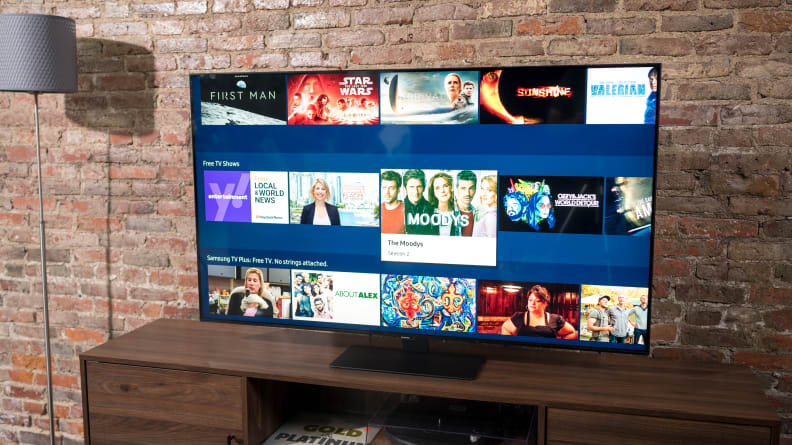
One of the Q80A's best qualities is that it gives you many of the same useful, proprietary Samsung features as the highest-end 2021 Neo QLED models.
Videophiles may want to note that you’re not getting Dolby Vision, as no Samsung TVs have that yet, unfortunately. Every other major HDR format is available, however.
What we don’t like
Not great for movie night
I’ve been reviewing TVs long enough that when I see a black level of almost 0.4 nits during testing, I assume it’s an error. You’d never see that on a VA-style LCD panel, which is the variant that most TVs use these days. For reference, the average VA black level is around 0.05 nits.
However, the 2021 Samsung Q80A uses an IPS-style ADS panel, which (like all tech) has pros and cons. You’re getting better-than-average viewing angles and good peak brightness, but the unconvincing shadows—we measured bright black levels regardless of whether the TV was displaying standard or HDR test patterns—make for a lot of issues.
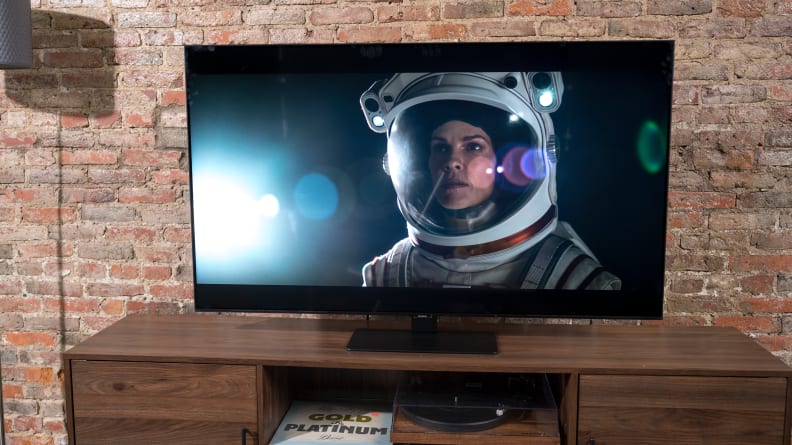
The IPS-style (ADS variant) LCD panel type that the Q80A series uses produce poor black levels, limiting their usability in dim or dark viewing environments.
Samsung has done its best to thwart these common IPS issues by equipping the Q80A with a full-array panel, but it still isn’t enough to solve the general problem of light pollution. Because TVs use additive digital color, they start with their primary colors (red, green, and blue) and add them together to create secondary colors, tertiary colors, and so on.
Each pixel has three primary sub-pixels (RGB), and to create a singular color (red, for example), the liquid crystal is electrified so that it closes up, blocking green and blue to allow light to pass only through red. When you’ve got a 0.4 black level, however, that means the “blocked” colors will still bleed some light through (roughly 0.4 nits of it, as it happens). Multiply that across millions of pixels, and it can create a picture that lacks clarity and depth.
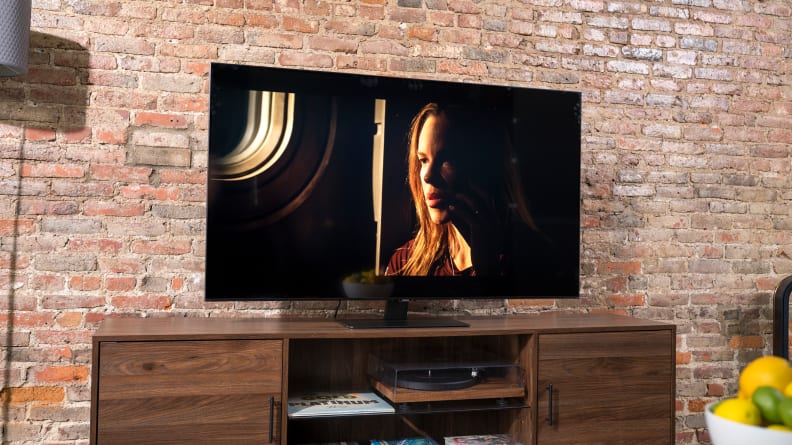
Even with lights on, close observation reveals a hazy, blue quality to the black areas around highlights. This is not ideal.
You probably won't notice this issue much if you're watching in a room with an average amount of light, or with bright lighting—an area where the Q80A might flourish—but it makes it a poor choice for dimmer or dark viewing environments, where nuance and subtlety are the coin of the realm.
Overall, this issue really hampers the Q80A as far as watching more filmic/cinematic content goes, which is a big knock against its core function as a product. We may live in a world where the last thing you use your smartphone for is making an actual phone call, but TVs still need to be able to provide some semblance of the cinema experience, even if they've got more features than you can shake a Roku stick at.
Should you buy it?
Maybe—if you have a very specific need for these features
Samsung’s Q80A presents an interesting conundrum when considered within Samsung’s extensive 2021 TV lineup. It delivers the next-gen gaming specs and a staggering list of features that you lose out on with the “entry-level” Q60A, while dropping the mini-LED backlight from the step-up QN85A, putting it somewhere right in the middle of Samsung’s 2021 TV lineup. It would be a great way to get next-gen features and QLED picture quality without the extra cost of mini-LEDs—if only it wasn’t using an IPS panel.
Because of its hampered cinematic viewing possibilities, the only way I can strongly recommend the Q80A is if you’re mainly going to be watching sports, news, nature docs, or playing snappy, next-gen video games. From that perspective, it does a lot right, and its IPS viewing angles make it a decent choice for groups and families. However, the poor contrast and sometimes muddled color separation may bother more eagle-eyed viewers.
Samsung’s flagship QN90A is hundreds of dollars more expensive than the Q80A, which really highlights the value of the latter's staggering feature set. But what you’re losing out on with this one is the flagship’s stellar Neo QLED picture quality, and it simply seems odd to buy a TV for its features first and its picture quality second.
If this is roughly your price range and you’d rather allocate your dollars towards picture quality first and foremost, consider that you could get Vizio’s excellent P-Series Quantum X, which offers excellent brightness and black levels, and have a little money left over for a good soundbar. If you’re just looking for solid 4K/HDR picture quality and don’t mind losing out on some of the posh Samsung styling, I highly recommend checking out the TCL's 2020 6-Series, which offers better picture quality than the Q80A for way less money. And if you’re still not sure, check out our constantly updated list of the best TVs right now.
Meet the testers
Lee was Reviewed's point person for most television and home theater products from 2012 until early 2022. Lee received Level II certification in TV calibration from the Imaging Science Foundation in 2013. As Editor of the Home Theater vertical, Lee oversaw reviews of TVs, monitors, soundbars, and Bluetooth speakers. He also reviewed headphones, and has a background in music performance.
Julia is the Senior Scientist at Reviewed, which means that she oversees (and continually updates) the testing of products in Reviewed's core categories such as televisions, washing machines, refrigerators, and more. She also determines the testing methods and standards for Reviewed's "The Best Right Now" articles.
Checking our work.
Our team is here to help you buy the best stuff and love what you own. Our writers, editors, and experts obsess over the products we cover to make sure you're confident and satisfied. Have a different opinion about something we recommend? Email us and we'll compare notes.
Shoot us an email